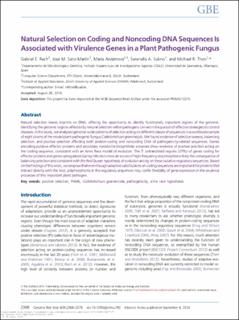Please use this identifier to cite or link to this item:
https://doi.org/10.21256/zhaw-3888Full metadata record
| DC Field | Value | Language |
|---|---|---|
| dc.contributor.author | Rech, Gabriel E. | - |
| dc.contributor.author | Sanz-Martín, José M. | - |
| dc.contributor.author | Anisimova, Maria | - |
| dc.contributor.author | Sukno, Serenella A. | - |
| dc.contributor.author | Thon, Michael R. | - |
| dc.date.accessioned | 2018-07-17T15:16:11Z | - |
| dc.date.available | 2018-07-17T15:16:11Z | - |
| dc.date.issued | 2014 | - |
| dc.identifier.issn | 1759-6653 | de_CH |
| dc.identifier.uri | https://digitalcollection.zhaw.ch/handle/11475/8275 | - |
| dc.description.abstract | Natural selection leaves imprints on DNA, offering the opportunity to identify functionally important regions of the genome. Identifying the genomic regions affected by natural selection within pathogens can aid in the pursuit of effective strategies to control diseases. In this study, we analyzed genome-wide patterns of selection acting on different classes of sequences in a worldwide sample of eight strains of the model plant-pathogenic fungus Colletotrichum graminicola. We found evidence of selective sweeps, balancing selection, and positive selection affecting both protein-coding and noncoding DNA of pathogenicity-related sequences. Genes encoding putative effector proteins and secondary metabolite biosynthetic enzymes show evidence of positive selection acting on the coding sequence, consistent with an Arms Race model of evolution. The 5′ untranslated regions (UTRs) of genes coding for effector proteins and genes upregulated during infection show an excess of high-frequency polymorphisms likely the consequence of balancing selection and consistent with the Red Queen hypothesis of evolution acting on these putative regulatory sequences. Based on the findings of this work, we propose that even though adaptive substitutions on coding sequences are important for proteins that interact directly with the host, polymorphisms in the regulatory sequences may confer flexibility of gene expression in the virulence processes of this important plant pathogen. | de_CH |
| dc.language.iso | en | de_CH |
| dc.publisher | Oxford University Press | de_CH |
| dc.relation.ispartof | Genome Biology and Evolution | de_CH |
| dc.rights | https://creativecommons.org/licenses/by/4.0/ | de_CH |
| dc.subject | Positive selection | de_CH |
| dc.subject | PAML | de_CH |
| dc.subject | Colletotrichum graminicola | de_CH |
| dc.subject | Pathogenicity | de_CH |
| dc.subject | Arms race hypothesis | de_CH |
| dc.subject.ddc | 570: Biologie | de_CH |
| dc.subject.ddc | 572: Biochemie | de_CH |
| dc.title | Natural selection at coding and non-coding DNA mainly affects pathogenicity-related genes in the hemibiotrophic fungus Colletotrichum graminicola | de_CH |
| dc.type | Beitrag in wissenschaftlicher Zeitschrift | de_CH |
| dcterms.type | Text | de_CH |
| zhaw.departement | Life Sciences und Facility Management | de_CH |
| zhaw.organisationalunit | Institut für Computational Life Sciences (ICLS) | de_CH |
| dc.identifier.doi | 10.21256/zhaw-3888 | - |
| dc.identifier.doi | 10.1093/gbe/evu192 | de_CH |
| zhaw.funding.eu | No | de_CH |
| zhaw.issue | 9 | de_CH |
| zhaw.originated.zhaw | Yes | de_CH |
| zhaw.pages.end | 2379 | de_CH |
| zhaw.pages.start | 2368 | de_CH |
| zhaw.publication.status | publishedVersion | de_CH |
| zhaw.volume | 6 | de_CH |
| zhaw.publication.review | Not specified | de_CH |
| zhaw.webfeed | Computational Genomics | de_CH |
| Appears in collections: | Publikationen Life Sciences und Facility Management | |
Files in This Item:
| File | Description | Size | Format | |
|---|---|---|---|---|
| evu192.pdf | 645.5 kB | Adobe PDF |  View/Open |
Show simple item record
Rech, G. E., Sanz-Martín, J. M., Anisimova, M., Sukno, S. A., & Thon, M. R. (2014). Natural selection at coding and non-coding DNA mainly affects pathogenicity-related genes in the hemibiotrophic fungus Colletotrichum graminicola. Genome Biology and Evolution, 6(9), 2368–2379. https://doi.org/10.21256/zhaw-3888
Rech, G.E. et al. (2014) ‘Natural selection at coding and non-coding DNA mainly affects pathogenicity-related genes in the hemibiotrophic fungus Colletotrichum graminicola’, Genome Biology and Evolution, 6(9), pp. 2368–2379. Available at: https://doi.org/10.21256/zhaw-3888.
G. E. Rech, J. M. Sanz-Martín, M. Anisimova, S. A. Sukno, and M. R. Thon, “Natural selection at coding and non-coding DNA mainly affects pathogenicity-related genes in the hemibiotrophic fungus Colletotrichum graminicola,” Genome Biology and Evolution, vol. 6, no. 9, pp. 2368–2379, 2014, doi: 10.21256/zhaw-3888.
RECH, Gabriel E., José M. SANZ-MARTÍN, Maria ANISIMOVA, Serenella A. SUKNO und Michael R. THON, 2014. Natural selection at coding and non-coding DNA mainly affects pathogenicity-related genes in the hemibiotrophic fungus Colletotrichum graminicola. Genome Biology and Evolution. 2014. Bd. 6, Nr. 9, S. 2368–2379. DOI 10.21256/zhaw-3888
Rech, Gabriel E., José M. Sanz-Martín, Maria Anisimova, Serenella A. Sukno, and Michael R. Thon. 2014. “Natural Selection at Coding and Non-Coding DNA Mainly Affects Pathogenicity-Related Genes in the Hemibiotrophic Fungus Colletotrichum Graminicola.” Genome Biology and Evolution 6 (9): 2368–79. https://doi.org/10.21256/zhaw-3888.
Rech, Gabriel E., et al. “Natural Selection at Coding and Non-Coding DNA Mainly Affects Pathogenicity-Related Genes in the Hemibiotrophic Fungus Colletotrichum Graminicola.” Genome Biology and Evolution, vol. 6, no. 9, 2014, pp. 2368–79, https://doi.org/10.21256/zhaw-3888.
Items in DSpace are protected by copyright, with all rights reserved, unless otherwise indicated.